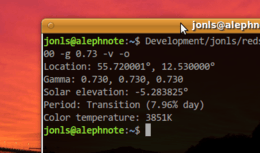Redshift (software)
|
| |
|
Redshift running in one-shot mode | |
| Developer(s) | Jon Lund Steffensen |
|---|---|
| Initial release | 4 November 2009[1] |
| Stable release |
1.11
/ 2 January 2016[2] |
| Written in | C, Python |
| Operating system | BSD, Linux, Windows |
| Available in | English |
| License | GPLv3 |
| Website | http://jonls.dk/redshift/ |
Redshift is an application that adjusts the computer display's color temperature based upon the time of day. The program is free software, inspired by the proprietary f.lux, and is intended to reduce eye strain as well as insomnia.[3]
Redshift transitions the computer display's color temperature evenly between daytime and night temperatures to allow the user's eyes to slowly adapt. At night, the color temperature is low and is typically 3000–4000 K, preferably matching the room's lighting temperature. Typical color temperature during the daytime is 5500–6500 K.
Features
Redshift is primarily distributed for and used on the Linux operating system. It is designed as a command line tool and can be directly controlled from the command line, enabled and disabled from a status icon, or configured to adjust the color temperature automatically. Redshift has some front-ends, including redshift-gtk, redshift-plasmoid, and nightshift. redshift-gtk is included in Redshift's source tree.
Redshift can be used to set a single color temperature and brightness ("one shot mode") or can adjust the temperature and brightness continuously to follow the sun's elevation, in which case it will transition to the night color temperature settings near twilight. The temperature and brightness settings for daytime and night can be user-configured.
To determine the Sun's elevation the software requires the user's location in form of latitude and longitude.[3]
On Linux and BSD operating systems, Redshift supports multiple monitors through the X extensions RandR (preferred) or VidMode, or through the Direct Rendering Manager. Because Redshift can only be configured to use the same gamma correction on all monitors it controls, it is usually desirable to run one instance of the program per monitor.
Reviews
Redshift has been positively reviewed by Linux users,[4][5][6] who note that Redshift has some installation and user interface advantages compared to the f.lux Linux port xflux. However, f.lux's systems have since been updated to enhance its dimmed display.[4]
See also
References
- ↑ "Redshift 0.1". 4 November 2009. Retrieved 26 October 2013.
- ↑ "Redshift releases".
- 1 2 Github release 1.9
- 1 2 Gordon, Whitson. "RedShift Makes Your Screen Easier on the Eyes at Night". LifeHacker. Retrieved 3 March 2015.
- ↑ Popov, Dmitri. "Improve Your Night Sleep with Redshift and F.lux". Linux Magazine. Retrieved 3 March 2015.
- ↑ Pot, Justin. "Redshift Keeps Your Eyes Sharp & Helps You Sleep [Linux]". MakeUseOf. Retrieved 3 March 2015.
